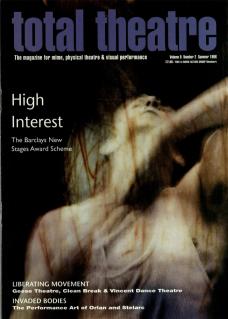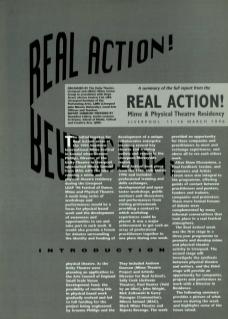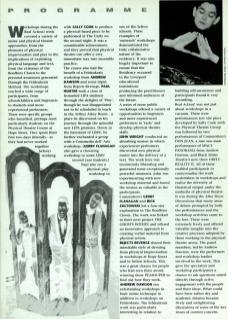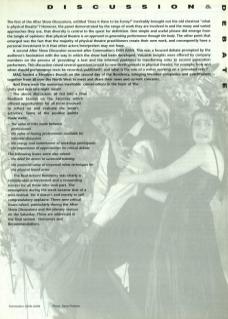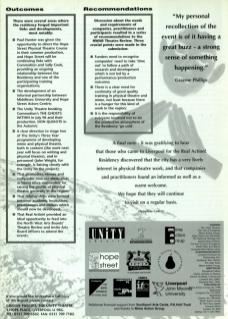Introduction
The initial impetus for Real Action! arose at the 1995 Northern International Mime Festival in Kendal when Graeme Phillips, Director of the Unity Theatre in Liverpool, approached Mhora Samuel from MAG with the idea of running a mime and physical theatre residency during the Liverpool LEAP '96 Festival of Dance, Mime and Physical Theatre.
A week-long series of workshops and performances would be a focus for physical based work and the development of awareness and opportunities to see and take part in such work. It would also provide a forum for debates surrounding the identity and funding of physical theatre. As the Unity Theatre were planning an application to the Arts Council of England Small Scale Venue Development Fund, the possibility of rooting this in physical based work gradually evolved and led to full funding for the project being engineered by Graeme Phillips and the development of a unique collaborative enterprise involving several key theatre and training outlets and venues in the Liverpool/Merseyside region.
Real Action! took place from the 11-16 March 1996 and included professional training and skills exchanges, developmental and open taster workshops, public seminars and discussions, and performances from visiting professionals providing a context in which workshop experiences could be placed. It was a major achievement to get such an array of professional practitioners together in one place during one week. They included Andrew Dawson (Mime Theatre Project and Artistic Director for Real Action!), Sally Cook (Activate Theatre), Paul Hunter (Told by an Idiot), John Wright, Rick Zoltowski and Gerry Flanagan (Commotion), Mhora Samuel (MAG), Black Mime Theatre and Rejects Revenge. The week provided an opportunity for these companies and practitioners to meet and exchange experiences, and above all to see each other’s work.
After Show Discussions, a Final Feedback Session, and a Promoters and Artists Forum were also integral to the programme, offering points of contact between practitioners and punters, funders and trainers, companies and promoters. These more formal forums of debate were complemented by many informal conversations that took place in a real festival atmosphere.
The Real Action! week was the first stage in a three-year programme to promote and develop mime and physical theatre activity in Liverpool. The second stage will investigate the synthesis between physical theatre and writers, and the third stage will provide an opportunity for companies, projects and performers to work with a Director in Residence.
The following summary provides a picture of what went on during the week and highlights some of the issues raised.
Programme
Workshops during the Real Action! week covered a variety of mime and physical theatre approaches, from the pleasures of physical improvisation and play to the implications of exploiting physical language and text; from the extremes of the Bouffon Clown to the personal awareness generated through the Feldenkrais Method. The workshops reached a wide range of participants, from schoolchildren and beginners to students and more experienced performers.
There were specific groups who benefited, perhaps most particularly students on the Physical Theatre Course at Hope Street. They spent their first two days (literally – as they had never worked together before) working with Sally Cook to produce a physical based piece to be performed at the Unity on the second night. It was a considerable achievement, and they proved that physical theatre can offer a very immediate way into ensemble practice.
The course also had the benefit of a Feldenkrais workshop from Andrew Dawson and some input from Rejects Revenge. Paul Hunter took a class of leotarded LIPA students through the delights of 'Play', though he was disappointed not to be scheduled to teach in the Arthur Askey Room – a place he discovered on his journey through the splendid new LIPA premises. Down in the basement of LJMU, he further enchanted a group with a Commedia dell'Arte workshop. (Gerry Flanagan also gave a clowning workshop to some LIMU second-year students.)
Paul also ran a physical play workshop in one of the Sefton schools. These examples of 'outreach' workshops demonstrated the truly collaborative nature of the residency. It was also hugely important to ensure that the Residency occurred in the Liverpool educational institutions producing the practitioners and informed audiences of the future.
A series of more public workshops offered a variety of opportunities to beginners and more experienced performers to 'taste' and develop physical theatre skills.
John Wright conducted an absorbing session in which experienced performers discovered new physical routes into the delivery of a text. The work here was enormously liberating and generated some exceptionally powerful moments. John was experimenting with new workshop material and found the session as valuable as the participants.
Commotion's Gerry Flanagan and Rick Zoltowski led a four-day exploration in The Bouffon Clown. The work was linked to their next project The Ghosts Within and offered an innovative approach to creating verbal material from physical action.
Rejects Revenge shared their inimitable style of devising from physical improvisation in workshops at Hope Street and in Sefton Schools. This was a great chance for people who had seen their award-winning show Peasouper to find out how they work.
Andrew Dawson ran entertaining workshops in basic mime technique in addition to workshops on Feldenkrais. The Feldenkrais work was particularly interesting in relation to building self-awareness and participants found it very rewarding.
Real Action! was not just about workshops in a vacuum. There were performances too: the piece developed by Sally Cook with the Physical Theatre Group was followed by two performances of Commotion's Don Juan, a rare one-man performance of Space Panorama from Andrew Dawson, and Black Mime Theatre's new show Dirty Reality II. All of these enabled participants to contextualise the work undertaken in workshops and realise the diversity of theatrical output under the umbrella of physical theatre. It was during the After Show Discussions that many areas of debate prompted by both the performances and the workshop activities came to the fore. These were extremely lively and offered valuable insights into the creative processes adopted by those working in the physical theatre arena. The panel members, led by Andrew Dawson, were the performers and workshop leaders involved in the week. This gave the spectators and workshop participants a chance to ask questions raised directly through active engagement with the people and their ideas. What could have been rather dry and academic debates became lively and enlightening discussions of some of the key issues of current concern.
Discussion and Debates
The first of the After Show Discussions, entitled 'Does it Have to be Funny?' inevitably brought out the old chestnut ‘what is physical theatre?’. However, the panel demonstrated by the range of work they are involved in and the many and varied approaches they use, that diversity is central to the quest for definition. One simple and useful phrase did emerge from the tangle of opinions: that physical theatre is an approach to generating performance through the body. The other point that emerged was the fact that the majority of physical theatre practitioners create their own work, and consequently have a personal investment in it that other actors/interpreters may not have.
A second After Show Discussion occurred after Commotion's Don Juan. This was a focused debate prompted by the audience's fascination with the way in which the show had been developed. Valuable insights were offered by company members on the process of 'provoking' a text and the inherent problems in transferring roles to second generation performers. This discussion raised several questions crucial to new developments in physical theatre, for example: how and when should performance texts be recorded/published, and what is the role of a writer working on a 'provoked’ text?
MAG hosted a Members Brunch on the second day of the Residency, bringing Member companies and practitioners together from all over the North West to meet and share their news and current concerns.
And there were the numerous inevitable conversations in the foyer of The Unity and over late night meals!
The above discussions all fed into a final Feedback Session on the Saturday which offered opportunities for all those involved to reflect on and evaluate the week's activities. Some of the positive points made were:
- the value of links made between professionals
- the value of having professionals available for informal discussion
- the energy and commitment of workshop participants
- the importance of opportunities for critical debate
The following issues were also raised:
- the need for access to sustained training
- the potential value of corporeal mime techniques for the physical based actor
The Real Action! residency was clearly a considerable achievement and a resounding success for all those who took part. The atmosphere during the week became that of a mini-festival. Yet it doesn't end merely in self congratulatory applause. There were critical issues raised, particularly during the After Show Discussions and the plenary session on the Saturday. These are addressed in the final section – Outcomes and Recommendations.
Outcomes
There were several areas where the residency forged important links and developments, most notably:
- Paul Hunter was given the opportunity to direct the Hope Street Physical Theatre Course in their summer production, and Hope Street will be continuing links with Commotion and Sally Cook, providing an ongoing relationship between the Residency and one of the participating training organisations.
- The development of an informal partnership between Middlesex University and Hope Street Actors Centre.
- The Unity Theatre booking Commotion's The Ghosts Within in July 96 and their production, Don Quixote in the autumn.
- A clear direction to stage two of the Unity's three-year programme of developing mime and physical theatre, both in content (the work next year will focus on writing and physical theatre), and in personnel (John Wright, for example, is liaising closely with the Unity on the project).
- That promoters, venues and companies now see themselves as being more responsible for raising the profile of physical theatre generally in the region.
- That relationships were formed between academic institutions, practitioners and venues which should now be developed.
- That Real Action! provided an ideal opportunity to feed into the North West Arts Boards Theatre Review and invite Arts Board officers to attend the events.
Recommendations
Discussion about the needs and requirements of companies, practitioners and participants resulted in a series of recommendations to the NWAB Theatre Review. Three crucial points were made in the submission:
- Funders need to recognise companies' need to take ‘time out' to follow a path of research and development which is not led by a performance/production outcome.
- There is a clear need for continuity of good quality training in physical theatre and mime, not least because there is a hunger for this kind of work in the region.
- It is the responsibility of everyone involved not to let the productive atmosphere of the Residency 'go cold'.
A final note – it was gratifying to hear that those who came to Liverpool for the Real Action!
residency discovered that the city has a very lively interest in physical theatre work, and that companies and practitioners found an informed as well as a warm welcome. We hope that they will continue to visit on a regular basis.
